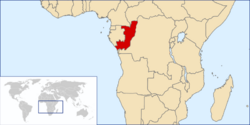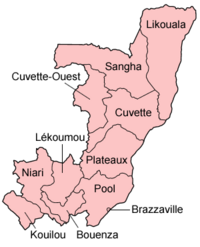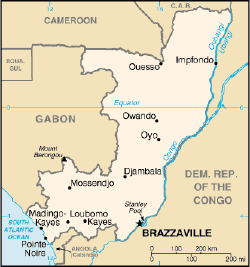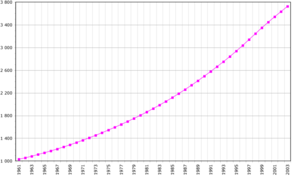Republic of the Congo
| République du Congo Republic of the Congo | |||||
| |||||
| Motto: "Unité, Travail, Progrès" (French) "Unity, Work, Progress" | |||||
| Anthem: La Congolaise | |||||
| Capital (and largest city) |
Brazzaville 4°14′S 15°14′E | ||||
| Official languages | French | ||||
|---|---|---|---|---|---|
| Government | Republic | ||||
| - President | Denis Sassou Nguesso | ||||
| - Prime Minister | Isidore Mvouba | ||||
| Independence | from France | ||||
| - Date | 15 August 1960 | ||||
| Area | |||||
| - Total | 342,000 km² (64th) 132,047 sq mi | ||||
| - Water (%) | 3.3 | ||||
| Population | |||||
| - 2005 estimate | 3,999,000 | ||||
| - {{{population_census_year}}} census | year = n/a | ||||
| - Density | 12/km² 31/sq mi | ||||
| GDP (PPP) | 2005 estimate | ||||
| - Total | $4.585 billion | ||||
| - Per capita | $1,369 | ||||
| HDI (2004) | |||||
| Currency | CFA franc (XAF)
| ||||
| Time zone | WAT (UTC{{{utc_offset}}}) | ||||
| Internet TLD | .cg | ||||
| Calling code | +242 | ||||
The Republic of the Congo, also known as Congo-Brazzaville (locally, "Congo-Brazza") or the Congo, is a former French colony of western-central Africa. It borders Gabon, Cameroon, Central African Republic, Democratic Republic of the Congo, Angola and the Gulf of Guinea. Upon independence in 1960, the former French region of Middle Congo became the Republic of the Congo. A quarter century of Marxism was abandoned in 1990 and a democratically elected government installed in 1992. A brief civil war in 1997 restored former Marxist President Denis Sassou Nguesso.
History and politics
The earliest inhabitants of the area were Pygmy peoples. They were largely replaced and absorbed by Bantu tribes of during Bantu expansions. The Bakongo are comprised of Bantu groups that also occupied parts of present-day Angola, Gabon, and Democratic Republic of the Congo, forming the basis for ethnic affinities and rivalries among those states. Several Bantu kingdoms—notably those of the Kongo, the Loango, and the Teke—built trade links leading into the Congo River basin. The first European contacts came in the late 15th century, and commercial relationships were quickly established with the kingdoms—trading for slaves captured in the interior. The coastal area was a major source for the transatlantic slave trade, and when that commerce ended in the early 19th century, the power of the Bantu kingdoms eroded.
Independence
Following independence as the Congo Republic on August 15 1960, Fulbert Youlou ruled as the country's first president until labour elements and rival political parties instigated a three-day uprising that ousted him. The Congolese military took charge of the country briefly and installed a civilian provisional government headed by Alphonse Massamba-Débat.
Under the 1963 constitution, Massamba-Débat was elected President for a five-year term but it was ended abruptly with an August 1968 coup d'état. Capt. Marien Ngouabi, who had participated in the coup, assumed the presidency on December 31, 1968. One year later, President Ngouabi proclaimed Congo to be Africa's first "people's republic" and announced the decision of the National Revolutionary Movement to change its name to the Congolese Labour Party (PCT). On March 16, 1977, President Ngouabi was assassinated. An 11-member Military Committee of the Party (CMP) was named to head an interim government with Col. (later Gen.) Joachim Yhombi-Opango to serve as President of the Republic.
1992 elections
After decades of turbulent politics bolstered by Marxist-Leninist rhetoric, and with the collapse of the Soviet Union, Congo completed a transition to multi-party democracy with elections in August 1992. Denis Sassou Nguesso conceded defeat and Congo's new president, Prof. Pascal Lissouba, was inaugurated on August 31, 1992.
1997 elections and civil unrest
However, Congo's democratic progress was derailed in 1997. As presidential elections scheduled for July 1997 approached, tensions between the Lissouba and Sassou camps mounted. On June 5, President Lissouba's government forces surrounded Sassou's compound in Brazzaville and Sassou ordered members of his private militia (known as "Cobras") to resist. Thus began a four-month conflict that destroyed or damaged much of Brazzaville and caused tens of thousands of civilian deaths. In early October, Angolan troops invaded Congo on the side of Sassou and, in mid-October, the Lissouba government fell. Soon thereafter, Sassou declared himself President. The Congo Civil War continued for another year and a half until a peace deal was struck between the various factions in December 1999.
2002 elections
Elections in 2002 saw Sassou win with almost 90% of the vote cast. His two main rivals Lissouba and Bernard Kolelas were prevented from competing and the only remaining credible rival, Andre Milongo, advised his supporters to boycott the elections and then withdrew from the race. A new constitution, agreed upon by referendum in January 2002, granted the president new powers and also extended his term to seven years as well as introducing a new bicameral assembly. International observers took issue with the organization of the presidential election as well as the constitutional referendum, both of which were reminiscent in their organization of Congo's era of the single-party state. Currently, Congo holds a rotating seat in the UN Security Council.
Political parties
The most important of the many parties are the Democratic and Patriotic Forces or FDP [Denis Sassou Nguesso, president], an alliance consisting of:
- Convention for Alternative Democracy
- Congolese Labour Party (PCT)
- Liberal Republican Party
- National Union for Democracy and Progress
- Patriotic Union for the National Reconstruction
- Union for the National Renewal
Other significant parties include:
- Congolese Movement for Democracy and Integral Development or MCDDI [Michel Mampouya]
- Pan-African Union for Social Development or UPADS [Martin Mberi]
- Rally for Democracy and Social Progress or RDPS [Jean-Pierre Thystere Tchicaya, president]
- Rally for Democracy and the Republic or RDR [Raymond Damasge Ngollo]
- Union for Democracy and Republic or UDR leader NA
- Union of Democratic Forces or UFD, Sebastian Ebao
Regions and districts
The Republic of the Congo is divided into ten régions (regions) and one commune, the capital Brazzaville. These are:
|
|
|
The regions are subdivided into forty-six districts.
Geography
Congo is located in the central-western part of sub-Saharan Africa, Equator. To the south and east of it is the Democratic Republic of Congo]]. It is also bounded by Gabon to the west, Cameroon and the Central African Republic to the north, and Cabinda (Angola) to the southwest. It has a short Atlantic coast.
The capital, Brazzaville, is located on the Congo River, in the south of the country, immediately across from Kinshasa, the capital of the Democratic Republic of the Congo.
The southwest of the country is a coastal plain for which the primary drainage is the Kouilou-Niari River; the interior of the country consists of a central plateau between two basins to the south and north. Below is a map of the Republic of the Congo.
Economy
The economy is a mixture of village agriculture and handicrafts, an industrial sector based largely on petroleum [1], support services, and a government characterized by budget problems and overstaffing. Petroleum extraction has supplanted forestry as the mainstay of the economy, providing a major share of government revenues and exports. In the early 1980s, rapidly rising oil revenues enabled the government to finance large-scale development projects with GDP growth averaging 5% annually, one of the highest rates in Africa. The government has mortgaged a substantial portion of its petroleum earnings, contributing to a shortage of revenues. The January 12, 1994 devaluation of Franc Zone currencies by 50% resulted in inflation of 61% in 1994, but inflation has subsided since. Economic reform efforts continued with the support of international organizations, notably the World Bank and the IMF. The reform program came to a halt in June 1997 when civil war erupted. When Sassou Nguesso returned to power at the war ended in October 1997, he publicly expressed interest in moving forward on economic reforms and privatization and in renewing cooperation with international financial institutions. However, economic progress was badly hurt by slumping oil prices and the resumption of armed conflict in December 1998, which worsened the republic's budget deficit. The current administration presides over an uneasy internal peace and faces difficult economic problems of stimulating recovery and reducing poverty, despite record-high oil prices since 2003. Natural gas and diamonds are also recent major Congolese exports, although Congo was excluded from the Kimberley Process in 2004 amid allegations that most of its diamond exports were in fact being smuggled out of the neighboring Democratic Republic of Congo.
Demographics
The Republic of the Congo's sparse population is concentrated in the southwestern portion of the country, leaving the vast areas of tropical jungle in the north virtually uninhabited. Thus, Congo is one of the most urbanized countries in Africa, with 85% of its total population living in a few urban areas, namely in Brazzaville, Pointe-Noire, or one of the small cities or villages lining the 332-mile railway which connects the two cities. In rural areas, industrial and commercial activity has declined rapidly in recent years, leaving rural economies dependent on the government for support and subsistence. Before the 1997 war, about 15,000 Europeans and other non-Africans lived in Congo, most of whom were French. Presently, only about 9,500 remain.
Weather and Climate
The best overall time to visit is probably June-September. (Avoid the rainy season, October-May.) Since the country is located on the Equator, the climate is consistent year-round — the average day temperature is a humid 75 F/24 C, with nights generally in the 60s F/16-21 C.
Culture
- List of writers from the Republic of the Congo
- Music of the Republic of the Congo
- Public holidays in the Republic of the Congo
See also
- Communications in the Republic of the Congo
- Foreign relations of the Republic of the Congo
- Military of the Republic of the Congo
- Transport in the Republic of the Congo
- Scouting in Congo-Brazzaville
Lists
- List of cities in the Republic of the Congo
- List of Democratic Republic of the Congo-related topics
- List of Republic of the Congo-related topics
ReferencesISBN links support NWE through referral fees
- Maria Petringa, Brazza, A Life for Africa (2006) ISBN 9781-4259-11980
External links
- News
- AllAfrica.com - Congo-Brazzaville news headline links
- IRIN News for Congo, from the United Nations
- Overviews
- Culture
- Directories
- Open Directory Project - Republic of the Congo directory category
- Stanford University - Africa South of the Sahara: Congo-Brazzaville directory category
- The Index on Africa - Congo-Brazzaville directory category
- University of Pennsylvania - African Studies Center: Congo directory category
- Yahoo! - Congo (Brazzaville) directory category
- Ethnic groups
- Baka Pygmies of Cameroon and Congo Culture and music of the first inhabitants of Congo
- Human Rights
- [2] Amnesty International Human Rights Report, 2006
- Tourism
- Travel guide to Republic of the Congo from Wikitravel
Benin • Burkina Faso • Cameroon • Côte d'Ivoire • Equatorial Guinea • Gabon • The Gambia • Ghana • Guinea • Guinea-Bissau • Liberia • Mali • Niger • Nigeria • Republic of the Congo • Senegal Sierra Leone • Togo
Sovereign states
Algeria ·
Angola ·
Benin ·
Botswana ·
Burkina Faso ·
Burundi ·
Cameroon ·
Cape Verde ·
Central African Republic ·
Chad ·
Democratic Republic of the Congo ·
Republic of the Congo ·
Comoros ·
Côte d'Ivoire ·
Djibouti ·
Egypt1 ·
Equatorial Guinea ·
Eritrea ·
Ethiopia ·
Gabon ·
The Gambia ·
Ghana ·
Guinea-Bissau ·
Guinea ·
Kenya ·
Lesotho ·
Liberia ·
Libya ·
Madagascar ·
Malawi ·
Mali ·
Mauritania ·
Mauritius ·
Morocco ·
Mozambique ·
Namibia ·
Niger ·
Nigeria ·
Rwanda ·
Senegal ·
Seychelles ·
Sierra Leone ·
Somalia ·
South Africa ·
Spain2 ·
Sudan ·
Swaziland ·
São Tomé and Príncipe ·
Tanzania ·
Togo ·
Tunisia ·
Uganda ·
Zambia ·
Zimbabwe
Dependencies | Unrecognized
British Indian Ocean Territory (UK) ·
French Southern and Antarctic Lands (France) ·
Mayotte (France) ·
Réunion (France) ·
St. Helena3 (UK)
|
Puntland ·
Somaliland ·
Sahrawi Arab Democratic Republic
1 Partly in Asia. 2 Mostly in Europe. 3 Includes the dependencies of Ascension Island and Tristan da Cunha.
Algeria · Angola · Benin · Botswana · Burkina Faso · Burundi · Cameroon · Cape Verde · Central African Republic · Chad · Comoros · Democratic Republic of the Congo · Republic of the Congo · Côte d'Ivoire · Djibouti · Egypt · Eritrea · Ethiopia · Equatorial Guinea · Gabon · The Gambia · Ghana · Guinea · Guinea-Bissau · Kenya · Lesotho · Liberia · Libya · Madagascar · Malawi · Mali · Mauritania · Mauritius · Mozambique · Namibia · Niger · Nigeria · Rwanda · São Tomé and Príncipe · Senegal · Seychelles · Sierra Leone · Somalia · South Africa · Sudan · Swaziland · Tanzania · Togo · Tunisia · Uganda · Western Sahara (SADR) · Zambia · Zimbabwe
| UN Security Council Members | |
|---|---|
| Permanent Members | |
| China - France - Russia - United Kingdom - United States | |
| Members 2021-2022 | |
| India - Ireland - Kenya - Mexico - Norway | |
| Members 2022-2023 | |
| Albania - Brazil - Gabon - Ghana - United Arab Emirates | |
| Member states and observers of La Francophonie | |
|---|---|
| Members | Albania · Andorra · Belgium (French Community) · Benin · Bulgaria · Burkina Faso · Burundi · Cambodia · Cameroon · Canada (New Brunswick • Quebec) · Cape Verde · Central African Republic · Chad · Cyprus1 · Comoros · Democratic Republic of the Congo · Republic of the Congo · Côte d'Ivoire · Djibouti · Dominica · Egypt · Equatorial Guinea · Former Yugoslav Republic of Macedonia · France (including French Guiana • Guadeloupe • Martinique • St. Pierre and Miquelon) · Gabon · Ghana1 · Greece · Guinea · Guinea-Bissau · Haiti · Laos · Luxembourg · Lebanon · Madagascar · Mali · Mauritania · Mauritius · Moldova · Monaco · Morocco · Niger · Romania · Rwanda · St. Lucia · São Tomé and Príncipe · Senegal · Seychelles · Switzerland · Togo · Tunisia · Vanuatu · Vietnam |
| Observers | |
| Senufo |
Gur |
Adamawa-Ubangi |
Kru |
Kwa |
CAR = Central African Republic DRC = Democratic Republic of the Congo
Credits
New World Encyclopedia writers and editors rewrote and completed the Wikipedia article in accordance with New World Encyclopedia standards. This article abides by terms of the Creative Commons CC-by-sa 3.0 License (CC-by-sa), which may be used and disseminated with proper attribution. Credit is due under the terms of this license that can reference both the New World Encyclopedia contributors and the selfless volunteer contributors of the Wikimedia Foundation. To cite this article click here for a list of acceptable citing formats.The history of earlier contributions by wikipedians is accessible to researchers here:
The history of this article since it was imported to New World Encyclopedia:
Note: Some restrictions may apply to use of individual images which are separately licensed.




